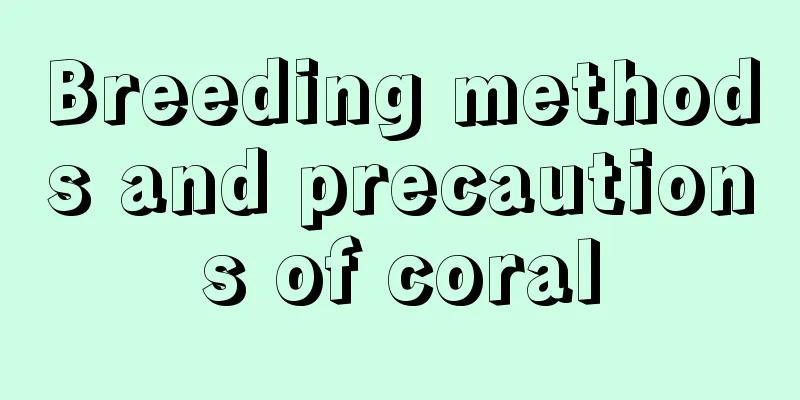Breeding methods and precautions of coral

How to cultivate coralSoil requirementsWhen cultivating, the potting soil should be sandy soil with good drainage and air permeability and rich in calcium. It can be made with 3 parts of river sand, 2 parts of shells, 2 parts of coal slag and 3 parts of leaf mold (pond soil). Planting methodPrepare a larger pot (a coarse clay pot is preferred), add the soil, and keep it slightly moist. Select some sturdier stem segments (one segment is enough) and plant them in pots. Then spray them with water to make the surface of the potting soil sticky, and then expose them directly to the sun. Don't water it frequently, and keep the soil in the pot dry. After a period of time, some golden thorns will begin to grow on the stems, and the stems will begin to become slightly flattened and widened, and take on a palm-shaped tendency. Do not water frequently, this is a way to force the growth of palm-shaped stems. If the new stems are kept in good quality and moisture from the beginning, the new stems will not tend to appear applause-shaped, but will grow in the same shape as the original plants. When the stems grow to about 2cm wide, they can be potted. Fertilization methodCoral plant should not be fertilized with chemical fertilizers, as it can easily cause root rot. It is better to apply less or no fertilizer. You can apply decomposed drying liquid twice in spring and late summer and early autumn with an interval of half a month. The soil in the pot should be dry but not wet. If it is too wet for a long time, it will cause the lower part of the plant to rot, and soon spread to the whole plant. Lighting requirementsIf the coral plant is placed in a room with insufficient light for a long time, it will grow too tall, the new stems will turn light green and become very thin, and the whole plant will take on a different flavor. But if it is then moved outdoors, the new stems will become thicker again, which will seriously affect the shape of the entire plant. Therefore, do not change the lighting conditions of the coral at will, and keep the lighting relatively stable. Precautions for breeding coralRepot once a yearIn the second year after transplanting, change the potting soil before the spring growing season and maintain the same management. During the peak growth period, completely palm-shaped stems will grow, but at this time the stems are not very large and the plant is not tall. If you want to get larger stems, you have to break off some of the extra stem buds and let it stand alone. In the spring of the third year, change to a larger pot. If managed properly, the largest stems will grow during the peak growth period. Avoid rotAfter the palm-shaped plant is fully formed, you must be extra careful with watering and fertilizing. Once it rots, it will be a huge loss of several years of hard work. The main points to note are: 1. Avoid applying concentrated fertilizers. 2. Better dry than wet. 3. Keep sufficient sunlight. |
Recommend
What flowers are suitable for growing in Ankang? What are the city flowers and trees?
1. Climate characteristics of Ankang Ankang City ...
How often should I water my camellia?
How often should I water my camellia? Camellia do...
Is the pearl spider plant easy to grow?
1. Is it easy to raise? Relatively speaking, pear...
Will the method of growing pumpkins on the balcony bear fruit?
It is good to grow pumpkin on the balcony. It is ...
Is the fortune tree afraid of cold?
1. Are you afraid of cold? The money tree is very...
Is it better to grow copper coins in water or soil?
Is it better to grow pennywort in water or soil? ...
How to take care of Dracaena in winter? This way the leaves will not turn yellow throughout the winter!
How to care for dragon blood tree in winter: Temp...
How to prune Luohan bamboo
When to prune Luohan bamboo When pruning Podocarp...
The flower language and legend of bird's nest fern
Flower language of bird's nest fern The flowe...
Causes and treatments for yellow leaves of Strelitzia reginae
1. Soil is alkaline 1. Reason: Strelitzia reginae...
Can Schefflera be repotted in summer? What to pay attention to after repotting (seedling acclimatization method)
Can Schefflera be repotted in summer? If you are ...
Hydroponic aloe vera, spider plant, red palm, green radish...if you don't pay attention to these points, they will die
1. Aloe Vera Because aloe vera plants have thick,...
Differences between blue flax and sesame flowers
1. Leaf Difference The leaves of blue flax are th...
This natural calcium tablet can be planted in a pot at home. It is crispy and delicious and can be eaten in half a month!
At this time, many flower lovers began to choose ...
Difference between poplar and birch
1. Differences between tree trunks Poplar trees a...









